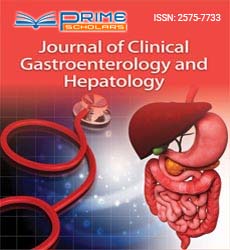Commentary - (2022) Volume 6, Issue 4
A Study on Cholangiocarcinoma Causes Symptoms and Treatment
Ruslan Johnson*
Department of Clinical Science, Karolinska University, Sweden
*Correspondence:
Ruslan Johnson, Department of Clinical Science, Karolinska University,
Sweden,
Email:
Received: 30-Mar-2022, Manuscript No. IPJCGH-22-13433;
Editor assigned: 01-Apr-2022, Pre QC No. IPJCGH-22-13433 (PQ);
Reviewed: 15-Apr-2022, QC No. IPJCGH-22-13433;
Revised: 20-Apr-2022, Manuscript No. IPJCGH-22-13433 (R);
Published:
27-Apr-2022, DOI: 10.36648/2575-7733.6.4.17
Description
Cholangiocarcinoma is a collection of cancerous growths in the
bile ducts. Bile channels are enlarged cylinders connecting the
liver and gallbladder to the small intestine. They transport bile,
a liquid that aids the body in the digestion of fats in diet. Bile is
produced in the liver and stored in the gallbladder before being
transported to the small intestine after a meal.
Cholangiocarcinoma is classified by the size of the tumour in
relation to the liver. Intrahepatic cholangiocarcinoma begins
in the liver’s small bile ducts. This is the most unusual kind of
infection, accounting for only 10% of all cases. Perihilar cholangiocarcinoma,
also known as Klatskin cancer, begins in the
hilum, which connects and separates the liver’s right and left
major bile conduits. It is the most common kind of infection,
accounting for the majority of cases, all things being equal. Distal
cholangiocarcinomas are cancers that begin in bile channels
outside of the liver. Extrahepatic cholangiocarcinoma refers to
both the perihilar and distal variants of the disease, which both
occur outside of the liver.
The three types of cholangiocarcinoma usually have no symptoms
in the early stages, and this malignant growth is not usually
investigated until it has moved beyond the bile pipes to
other tissues. When bile ducts are obstructed by the growth,
side symptoms are common. The most well-known side effect
is jaundice, which causes yellowing of the skin and eyes.
Other adverse effects include excessive tiredness (weakness),
tingling, dull-colored pee, loss of appetite, unexpected weight
loss, stomach pain, and light-colored and greasy faeces. These
adverse effects are described as “vague” since they can be
symptoms of a variety of diseases.
Many persons who develop cholangiocarcinoma are older than
65 years old. Because this disease is frequently not discovered
until it has already spread, it is difficult to treat. Depending on
the location of the malignant growth and how advanced it is,
impacted persons can make do for a long time to a long time
following diagnosis.
Malignant growths occur when a series of alterations in basic
features — such as those that drive cell division — allow cells
to develop and partition erratically, becoming a cancer. These
inherited alterations are acquired during an individual’s lifetime
in many cases of cholangiocarcinoma and are only present
in the bile conduit cells that cause the development. Significant
transformations are inherited alterations that cannot be
acquired. Cholangiocarcinoma has been discovered to exhibit
significant changes in several qualities. Some of these features
act as cancer silencers, which means they help keep cell growth
and division under control.
Changes in or cancellations of growth silencer properties can
allow cells to divide and develop without control, which is an
indication of illness. Oncogenes are different qualities associated
with cholangiocarcinoma; when they are turned on (actuated)
in uncommon ways, these attributes can potentially cause
normal cells to become cancerous. Physical changes in cholangiocarcinoma
may indicate how quickly the cancer will grow
and spread, as well as which treatments will be most effective.
Acknowledgement
None.
Conflict of Interest
Authors declare no conflict of interest.
Citation: Johnson R (2022) A Study on Cholangiocarcinoma Causes Symptoms and Treatment. J Clin Gastroenterol Hepatol. 6:17.
Copyright: © Johnson R. This is an open-access article distributed under the terms of the Creative Commons Attribution License, which permits unrestricted use, distribution, and reproduction in any medium, provided the original author and source are credited.

